Java Polymorphism - Shape Class with Circle, Rectangle, and Triangle Subclasses for Area and Perimeter Calculation
Write a Java program to create a class Shape with methods getArea() and getPerimeter(). Create three subclasses: Circle, Rectangle, and Triangle. Override the getArea() and getPerimeter() methods in each subclass to calculate and return the area and perimeter of the respective shapes.
In the given exercise, here is a simple diagram illustrating polymorphism implementation:
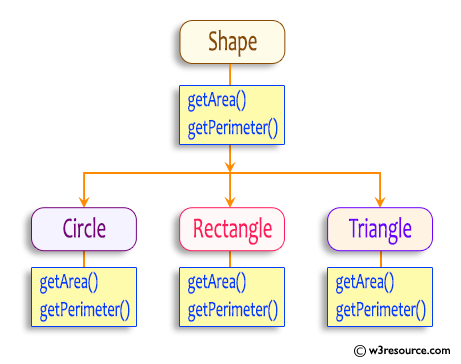
In the above diagram, the Circle, Rectangle, and Triangle classes have the getArea() and getPerimeter() methods. These methods allow them to calculate and return the area and perimeter specific to each shape.
Sample Solution:
Java Code:
// Shape.java
// Base class Shape
abstract class Shape { // Declare an abstract class Shape
public abstract double getArea(); // Declare an abstract method getArea that returns a double
public abstract double getPerimeter(); // Declare an abstract method getPerimeter that returns a double
}
// Circle.java
// Subclass Circle
class Circle extends Shape { // Declare a subclass Circle that extends the Shape class
private double radius; // Declare a private double variable radius
public Circle(double radius) { // Define a constructor that takes a double parameter radius
this.radius = radius; // Initialize the radius variable with the provided parameter
}
@Override // Override the getArea method from the Shape class
public double getArea() { // Define the getArea method
return Math.PI * radius * radius; // Calculate and return the area of the circle
}
@Override // Override the getPerimeter method from the Shape class
public double getPerimeter() { // Define the getPerimeter method
return 2 * Math.PI * radius; // Calculate and return the perimeter of the circle
}
}
// Rectangle.java
// Subclass Rectangle
class Rectangle extends Shape { // Declare a subclass Rectangle that extends the Shape class
private double length; // Declare a private double variable length
private double width; // Declare a private double variable width
public Rectangle(double length, double width) { // Define a constructor that takes two double parameters length and width
this.length = length; // Initialize the length variable with the provided parameter
this.width = width; // Initialize the width variable with the provided parameter
}
@Override // Override the getArea method from the Shape class
public double getArea() { // Define the getArea method
return length * width; // Calculate and return the area of the rectangle
}
@Override // Override the getPerimeter method from the Shape class
public double getPerimeter() { // Define the getPerimeter method
return 2 * (length + width); // Calculate and return the perimeter of the rectangle
}
}
// Triangle.java
// Subclass Triangle
class Triangle extends Shape { // Declare a subclass Triangle that extends the Shape class
private double side1; // Declare a private double variable side1
private double side2; // Declare a private double variable side2
private double side3; // Declare a private double variable side3
public Triangle(double side1, double side2, double side3) { // Define a constructor that takes three double parameters side1, side2, and side3
this.side1 = side1; // Initialize the side1 variable with the provided parameter
this.side2 = side2; // Initialize the side2 variable with the provided parameter
this.side3 = side3; // Initialize the side3 variable with the provided parameter
}
@Override // Override the getArea method from the Shape class
public double getArea() { // Define the getArea method
double s = (side1 + side2 + side3) / 2; // Calculate the semi-perimeter of the triangle
return Math.sqrt(s * (s - side1) * (s - side2) * (s - side3)); // Calculate and return the area of the triangle using Heron's formula
}
@Override // Override the getPerimeter method from the Shape class
public double getPerimeter() { // Define the getPerimeter method
return side1 + side2 + side3; // Calculate and return the perimeter of the triangle
}
}
// Main.java
// Main class
public class Main { // Declare the Main class
public static void main(String[] args) { // Define the main method
double r = 4.0; // Initialize a double variable r with the value 4.0
Circle circle = new Circle(r); // Create an instance of the Circle class with radius r
double rs1 = 4.0, rs2 = 6.0; // Initialize double variables rs1 and rs2 with the values 4.0 and 6.0 respectively
double ts1 = 3.0, ts2 = 4.0, ts3 = 5.0; // Initialize double variables ts1, ts2, and ts3 with the values 3.0, 4.0, and 5.0 respectively
Rectangle rectangle = new Rectangle(rs1, rs2); // Create an instance of the Rectangle class with sides rs1 and rs2
Triangle triangle = new Triangle(ts1, ts2, ts3); // Create an instance of the Triangle class with sides ts1, ts2, and ts3
System.out.println("Radius of the Circle"+r); // Print the radius of the circle
System.out.println("Area of the Circle: " + circle.getArea()); // Print the area of the circle
System.out.println("Perimeter of the Circle: " + circle.getPerimeter()); // Print the perimeter of the circle
System.out.println("\nSides of the rectangle are: "+rs1+','+rs2); // Print the sides of the rectangle
System.out.println("Area of the Rectangle: " + rectangle.getArea()); // Print the area of the rectangle
System.out.println("Perimeter of the Rectangle: " + rectangle.getPerimeter()); // Print the perimeter of the rectangle
System.out.println("\nSides of the Triangle are: "+ts1+','+ts2+','+ts3); // Print the sides of the triangle
System.out.println("Area of the Triangle: " + triangle.getArea()); // Print the area of the triangle
System.out.println("Perimeter of the Triangle: " + triangle.getPerimeter()); // Print the perimeter of the triangle
}
}
Output:
Radius of the Circle4.0 Area of the Circle: 50.26548245743669 Perimeter of the Circle: 25.132741228718345 Sides of the rectangle are: 4.0,6.0 Area of the Rectangle: 24.0 Perimeter of the Rectangle: 20.0 Sides of the Traiangel are: 3.0,4.0,5.0 Area of the Triangle: 6.0 Perimeter of the Triangle: 12.0
Flowchart:
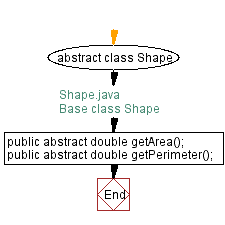
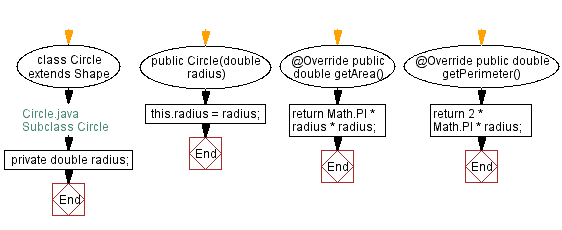
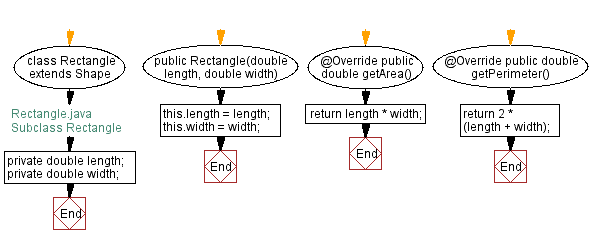

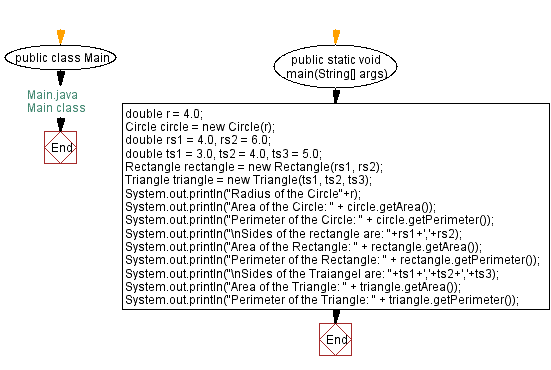
For more Practice: Solve these Related Problems:
- Write a Java program where the "Shape" class includes a method to check if two shapes have equal area.
- Write a Java program where the "Shape" class implements a method to rotate the shape by a given angle.
- Write a Java program where the "Shape" class calculates the difference in perimeter between two shapes.
- Write a Java program where the "Shape" class supports color properties with predefined values.
Go to:
Java Code Editor:
Contribute your code and comments through Disqus.
PREV : Sports Class with Football, Basketball, and Rugby Subclasses for Playing Statements.
NEXT : Animal Base Class with Bird and Panthera Subclasses.
What is the difficulty level of this exercise?
